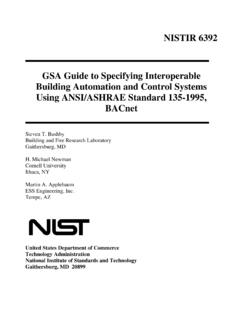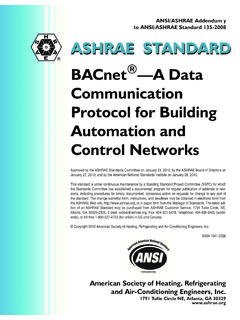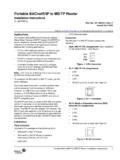Transcription of BACnet A Data Communication Protocol for …
1 ANSI/ASHRAE Addendum d to ANSI/ASHRAE Standard 135-2001. BACnet A Data Communication Protocol for Building Automation and Control Networks Approved by the ASHRAE Standards Committee on October 5, 2003; by the ASHRAE Board of Directors on January 29, 2004; and by the American National Standards Institute on February 25, 2004. This standard is under continuous maintenance by a Standing Standard Project Committee (SSPC) for which the Standards Committee has established a documented program for regular publication of addenda or revisions, including procedures for timely, documented, consensus action on requests for change to any part of the standard. The change submittal form, instruc- tions, and deadlines may be obtained in electronic form from the ASHRAE web site, , or in paper form from the Manager of Standards. The latest edition of an ASHRAE Stan- dard and printed copies of a public review draft may be pur- chased from ASHRAE Customer Service, 1791 Tullie Circle, NE, Atlanta, GA 30329-2305.
2 E-mail: Fax: 404-321- 5478. Telephone: 404-636-8400 (worldwide), or toll free 1-800-527- 4723 (for orders in and Canada). Copyright 2004 American Society of Heating, Refrigerating and Air-Conditioning Engineers, Inc. ISSN 1041-2336. ASHRAE STANDING STANDARD PROJECT COMMITTEE 135. Cognizant TC: TC , Control Theory and Applications SPLS Liaison: Frank E. Jacob Steven T. Bushby, Chair* Troy Cowan* David Robin William O. Swan III, Vice-Chair Thomas S. Ertsgaard* Daniel A. Traill*. Carl Neilson, Secretary Craig P. Gemmill* J. Michael Whitcomb*. Barry B. Bridges* Robert L. Johnson David P. White James F. Butler* Stephen T. Karg*. A. J. Capowski* J. Damian Ljungquist*. *Denotes members of voting status when this standard was approved for publication. _____. ASHRAE STANDARDS COMMITTEE 2003-2004. Van D. Baxter, Chair Matt R. Hargan Cyrus H. Nasseri Davor Novosel, Vice-Chair Richard D. Hermans Gideon Shavit Donald B. Bivens John F. Hogan David R. Tree Dean S.
3 Borges Frank E. Jakob Thomas H. Williams Paul W. Cabot Stephen D. Kennedy James E. Woods Charles W. Coward, Jr. David E. Knebel Kent W. Peterson, CO. Hugh F. Crowther Frederick H. Kohloss Ross D. Montgomery, BOD ExO. Brian P. Dougherty Merle F. McBride Hakim Elmahdy Mark P. Modera Claire B. Ramspeck, Manager of Standards _____. SPECIAL NOTE. This American National Standard (ANS) is a national voluntary consensus standard developed under the auspices of the American Society of Heating, Refrigerating and Air-Conditioning Engineers (ASHRAE). Consensus is defined by the American National Standards Institute (ANSI), of which ASHRAE is a member and which has approved this standard as an ANS, as substantial agreement reached by directly and materially affected interest categories. This signifies the concurrence of more than a simple majority, but not necessarily unanimity. Consensus requires that all views and objections be considered, and that an effort be made toward their resolution.
4 " Compliance with this standard is voluntary until and unless a legal jurisdiction makes compliance mandatory through legislation. ASHRAE obtains consensus through participation of its national and international members, associated societies, and public review. ASHRAE Standards are prepared by a Project Committee appointed specifically for the purpose of writing the Standard. The Project Committee Chair and Vice-Chair must be members of ASHRAE; while other members may or may not be members of ASHRAE, all must be technically qualified in the subject area of the standard. Every effort is made to balance the concerned interests on all Project Committees. The Manager of Standards of ASHRAE should be contacted for: a. interpretation of the contents of this Standard, b. participation in the next review of the Standard, c. offering constructive criticism for improving the Standard, d. permission to reprint portions of the Standard. DISCLAIMER. ASHRAE uses its best efforts to promulgate standards for the benefit of the public in light of available information and accepted industry practices.
5 However, ASHRAE does not guarantee, certify, or assure the safety or performance of any products, components, or systems tested, designed, installed, or operated in accordance with ASHRAE's Standards or Guidelines or that any tests conducted under its standards will be nonhazardous or free from risk. ASHRAE INDUSTRIAL ADVERTISING POLICY ON STANDARDS. ASHRAE Standards and Guidelines are established to assist industry and the public by offering a uniform method of testing for rating purposes, by suggesting safe practices in designing and installing equipment, by providing proper definitions of this equipment and by providing other information which may serve to guide the industry. The creation of ASHRAE Standards is determined by the need for them, and conformance to them is completely voluntary. In referring to this standard and marking of equipment and in advertising, no claim shall be made, either stated or implied, that the product has been approved by ASHRAE.
6 (This foreword is not part of this standard. It is merely informative and does not contain requirements necessary for conformance to the standard.). FOREWORD. The purpose of this addendum is to add a number of independent substantive changes to the BACnet standard. These modifications are the result of change proposals made pursuant to the continuous maintenance procedures contained in the Manual for Processing ASHRAE Standards and PC Guidance and of deliberations within Standing Standard Project Committee 135. The changes are summarized below. 135d-1. Add clauses describing BACnet -EIB/KNX mapping, p. 1. In the following document, language to be added to existing clauses of ANSI/ASHRAE 135-2001 and Addenda is indicated through the use of italics, while deletions are indicated by strikethrough. Where entirely new subclauses are proposed to be added, plain type is used throughout. 135d-1. Add clauses describing BACnet -EIB/KNX mapping. Addendum 135d-1.
7 [Add to Contents, p. iv]. Using BACnet with EIB/KNX. [Add to Clause , p. 5]. EIB European Installation Bus EIBA European Installation Bus Association KNX The Konnex System Specification: EIB is the core Protocol of the Konnex standard. The Konnex System Specification reflects the current status for EIB. [Add to Clause 21, p. 389 ff]. BACnetEngineeringUnits ::= ENUMERATED {.. -- Acceleration meters-per-second-per-second (166), --Electrical amperes-per-meter (167), amperes-per-square-meter (168), ampere-square-meters (169), farads (170), henrys (171), ohm-meters (172), siemens (173), siemens-per-meter (174), teslas (175), volts-per-degree-Kelvin (176), volts-per-meter (177), webers (178), --Light candelas (179), candelas-per-square-meter (180), --Temperature degrees-Kelvin-per-hour (181), degrees-Kelvin-per-minute (182), --Other joule-seconds (183), radians-per-second (184), square-meters-per-Newton (185), kilograms-per-cubic-meter (186), newton-seconds (187), newtons-per-meter (188), watts-per-meter-per-degree-Kelvin (189).}
8 }. -- Enumerated values 0-255 are reserved for definition by ASHRAE. Enumerated values -- 256-65535 may be used by others subject to the procedures and constraints described Addendum d to ANSI/ASHRAE Standard 135-2001 1. -- in Clause 23. The last enumeration used in this version is 144 189. [Add to Clause 25, p. 423]. Konnex Handbook Volume 3: System Specifications Konnex Handbook Volume 3: System Specifications, Part 7: Interworking, Chapter 2: Datapoint Types Konnex Handbook Volume 3: System Specifications, Part 7: Interworking, Chapter 3: Standard Identifier Tables, Annex 1 Property Identifiers Konnex Handbook Volume 7: Applications Descriptions [Add to Clause 25, Sources for Reference Material, p. 424]. EIBA: EIB Association (EIBA) , Neerveldstraat / Rue de Neerveld 105, B-1200 Brussels, Belgium Konnex Association: Neerveldstraat / Rue de Neerveld 105, B-1200 Brussels, Belgium [Add the following clauses, from through , to normative Annex H, p.]
9 523]. Using BACnet with EIB/KNX. This clause describes how BACnet objects and properties are mapped to corresponding EIB/KNX Datapoints and Functional Blocks. Functional Blocks are part of the Interworking Model defined by the EIB Association / Konnex Association. In the following clauses, references to "EIB" also apply to Konnex. Object Structures The following subclauses describe the relationship between EIB Functional Blocks and BACnet objects. EIB. EIB Functional Blocks not only describe the semantics of a function in the English language, but also define how to access the services associated with that function. This is done on the basis of "Datapoints." The Datapoints are divided into two principal categories, input and output. A Functional Block consists of a non-empty collection of one or more input and output Datapoints. At least one Datapoint is required. Functional Blocks are contained within Physical Devices. A Physical Device implements at least one Functional Block.
10 It may be regarded as a container for, or collection of, Functional Blocks. BACnet BACnet 's object types define functions in terms of semantics and the services used to access these functions. To accomplish this task, BACnet object types contain properties. An object type consists of a non-empty collection of properties, some of which are mandatory while others may be optional. BACnet also defines a Device object and a " BACnet Device" contains a collection of instances of object types. Each BACnet Device contains one, and only one, Device object. See Typically, each physical device corresponds to a single BACnet Device and therefore contains a single Device object. An exception is described in Relationship of EIB to BACnet EIB Functional Blocks are comparable to BACnet object types while EIB Datapoints correlate to BACnet properties. Mapping Rules for the BACnet Device Object Type This clause provides rules for the assignment of values to the properties of the BACnet Device object type.













